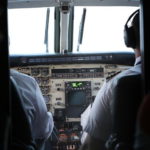UMS SKELDAR executives – David Willems, head of business development, and Ewen Stockbridge Sime, former RAF Squadron Leader, head of training and founding director of 360ISR Ltd – examine the future of UAVs.
When asked to investigate the future of any sector, one tends to resort to examining trends mixed with intuition, potential scenarios based on strategic understanding and, to be frank, a certain amount of guesswork. Perhaps our views are also based on that elusive ‘wish-list’ we secretly like to roll out, but rarely fulfil.
There are an almost limitless number of applications that will involve UAV strategies and deployment of associated solutions.
The challenge in the unmanned aerial vehicle (UAV) sector is doubly hard because of the dynamic marketplace and current pace of change.
That said, the interesting factor is that while a platform may adapt propulsion systems – add vertical boosters here or delta wings there – or deploy the latest set of payloads and sensors, the common denominator driving growth remains the same.
Platforms will add bells and whistles because innovation and efficiencies will dictate physical changes, but the most exciting part of crystal-ball-gazing is the almost limitless number of applications that will involve UAV strategies and deployment of associated solutions.
Doing the numbers
Think about it. Over the past 20 years, we have witnessed exponential growth from a quirky, interesting hybrid to what is now becoming considered a mainstream solution in military and civilian domains.
The market value – fuelled by military R&D – illustrates the potential of the UAV across a plethora of applications. It is estimated to be $20.71 billion in 2018 and is projected to reach $52.3 billion by 2025, at a CAGR of 14.15% from 2018 to 2025.
Interestingly, whilst R&D has been pushed from the military side, the spin-off and main beneficiary has been the civilian market. Based on application, the civil and commercial application segment of the UAV market is projected to grow at the highest CAGR from 2018 to 2025. This growth can be attributed to the increased adoption of UAVs for various civil and commercial applications, such as inspection, monitoring, surveying, mapping and remote sensing. UAVs’ properties, such as superior endurance, high efficiency and low operating costs, have fuelled the use of UAVs in civil and commercial applications.
So, what is the changing role of UAVs? Right now, there is a need for their applications to develop due to their evolving environment. The cost is a major factor to also be considered, as a UAV should always be more cost-effective than a manned vehicle, whilst maintaining operational parity.
Leading from the front
Whatever the reason for acquiring a UAV capability, it is critical to implement it correctly. We can learn from the Royal Netherlands Air Force. They started a procurement process for the MQ-9 Reaper (sometimes called Predator B) many years ago.
Whilst waiting for the systems, the Dutch realised that they needed a robust communications infrastructure on which to carry the terabytes of data, and they would also need intelligence centres.
To cap it all, they needed training. They achieved all of this before the first aircraft was delivered. This clearly demonstrates that a UAV is not just an air vehicle and control station; it is a means to create intelligence and support decision-making.
The Concept of Operations (CONOPs) is all too important, and often an afterthought. UMS SKELDAR has worked on many such projects, from the introduction of UAVs into an urban centre to support for migration monitoring in the Mediterranean. The CONOP is the document that establishes a road map and sets direction, and as such, it should not be forgotten.
The CONOP is the document that establishes a road map and sets direction, and as such it, should not be forgotten.
UAVs are normally a tactical asset. That said, the UAV can have dramatic strategic effect. For example, with the Gatwick airport shutdown, nobody understood why the UAV was there, who had done it or what the motive was. This small drone was able to cause a colossal amount of problems and have a major impact.
Closing a huge airport is asymmetric warfare at its best. This has, of course, spawned a whole new industry of counter-UAV technology.
Intelligence asset
UAVs allow us to take part in what is termed ‘5th Generation and asymmetric warfare’, as they enable us to have an intelligence and kinetic effect across a range of scenarios, transforming tactical action by a UAV to strategic effect. Against the backdrop of risk aversion, cost accountability and political fall-out, it is going to become more and more important for western militaries to become intelligence-led.
Intelligence from UAVs has been used to huge effect in military and commercial applications, from counter-drug operations to EMSA (European Maritime Safety Agency) emissions testing and monitoring. In the recently awarded contract, UAVs supplied by UMS SKELDAR have become the tactical tool to help governments apply legislation and regulate GHG (greenhouse gas) emissions from international shipping.
Counting the cost
Procurement will be based on contracts to own/operate similar to a leasing agreement, and although the original concept was developed for civilian customers from oil companies to infrastructure maintenance teams, we will see flexible finance options become increasingly popular in the military market.
What is the point of buying a UAV that is relevant now but won’t be in two years’ time? One thing is constant in the UAV market: change! As the technology is rapidly changing and evolving, redundancy is a given and future-proofing becomes a necessity rather than a nice-to-have.
Deep learning can be achieved through algorithms and smart software that allows intelligence systems and solutions to leverage constantly developing technologies.
Rules of the game
Regulatory frameworks will also need to develop in parallel with system capabilities. Worldwide civil aviation authorities have been playing catch-up and in the case of the US especially, legislation has been seen as potentially strangling R&D in a sector that thrives on the latest great idea.
Regulatory frameworks will also need to develop in parallel with system capabilities.
There will be a need for aviation authorities to review the laws surrounding UAVs – in a search-and-rescue context, the UAVs will be deployed to find people in a certain defined box and can then send an alarm if they find someone but they need to be allowed into potentially restricted airspaces.
Outside of the laws of physics, the main limiting factor for UAVs is our perception of them and how we accept, or otherwise, their capability.
The role of the UAV will change, and innovation will come in the commercial, wildlife and environmental, urban planning and urban networks sector. Small, hungry start-ups looking to disrupt the global primes with agility will develop ingenious applications for UAVs.
Currently, the environment will drive change and demand that the world starts to monitor pollution.
UMS SKELDAR, for example, is already monitoring exhaust emissions from ships transiting through European waters, as well as developing CONOPs for plastic monitoring in the oceans, ice cap conditions and surface pollution caused by oil spills.
Risk and reward
Innovative thinking is better rewarded in the commercial sector. A notable example is the Singapore government, which has opened airspace for UAVs in the city to prove the concept that UAV will not crash into high-rise buildings when programmed correctly through a network replicating cellular telecoms systems.
This opens a range of possibilities, including transport and emergency supplies – all contributing to and very much in line with smart city thinking.
The key point to remember is that the capabilities of the UAV itself will not change that much; the acceptance of the UAV and therefore the roles that they are permitted to take on will change, however.
Lessons learned
In order to change perceptions, people need to be made more aware of the various roles and purposes of a UAV. We need to learn lessons from the motor car industry and move on from waving a red flag in front of each vehicle for fear of spooking the horses.
As well as learning lessons about the acceptance and employment of UAVs, we must also understand that a UAV is much more than an aircraft and a control station; it is a system that supports decision making by delivering intelligence.
A UAV is much more than an aircraft and a control station; it is a system that supports decision making by delivering intelligence.
In the future, for the military sector, commanders need to know the best strategies for integrating UAVs. Gone are the days of stove-piped intelligence systems owned at the tactical level.
Understanding the mission-space within your area of physical influence is no longer enough. Units need to be able to lever from each other’s UAVs and the data and intelligence derived from them.
The UAVs will be operated at the tactical level but feed the operational picture and enable the commander to assess operational success or failure, increasingly in real-time. This aspect of UAV operations is fundamental to fifth-generation warfare.
We are seeing the need for UAV understanding to break out of the silos of expertise – whether defence establishments, military units or civilian markets, to a holistic understanding of the almost limitless potential for UAV strategies and tactics.
What is undeniable is the fact that UAVs have changed the pace of aerospace development, shaken up military tactics and re-written the rule books for manned and unmanned aviation. Hold on tight, it’s going to get even more interesting!

